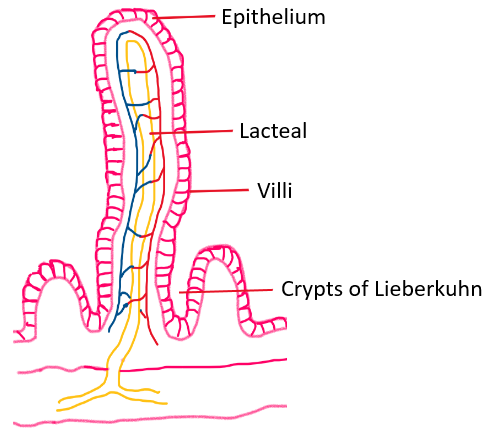
‘Crypts of Lieberkühn’ are found in
(a) Gallbladder
(b) Liver
(c) Pancreas
(d) Intestinal glands
Answer
575.1k+ views
Hint: Crypts of Lieberkühn is observed in the organ where the end absorption of several nutrients and minerals occurs. This organ is situated between the stomach and the large intestine.
Complete answer:
The intestinal gland is called the crypt of Lieberkühn which is observed in between the villi of the epithelial lining of the small intestine and the large intestine. This gland is named after the German anatomist J. N. Lieberkühn. The secretion of this gland is called intestinal juice or the succus entericus, which is alkaline and has a pH of 8.3. Intestinal juice is secreted by the hormones, vagus nerve, and the mechanical stimulation produced by the presence of food.
The cells of these glands are known as Paneth cells that secrete the intestinal juice and they are found along the side of the crypt and the villus.
Intestinal juice is a clear to pale yellow secretion which is composed of various digestive enzymes, mucus, hormones, and other neutralizing substances that are released from the glands and the mucous membrane lining of the small and the large intestine. Intestinal juice will neutralize the hydrochloric acid that gets secreted from the stomach. Furthermore, it releases the gastrointestinal hormones to the bloodstream and it contains the digestive enzyme that will facilitate the digestion of food and its absorption.

So, the correct answer is ‘Intestinal glands’.
Note:The enzymes that are present in the intestinal juice act upon the end products which are obtained after the pancreatic juice action. Dipeptides are acted upon by the peptidases present in the intestinal juice that converts it into the simpler absorbable amino acids. Mucus, secreted from the goblet cells along with the bicarbonates from the pancreas will provide an alkaline medium (pH 7.8) in the small intestine which in turn will protect the intestinal mucosa from the acid.
Complete answer:
The intestinal gland is called the crypt of Lieberkühn which is observed in between the villi of the epithelial lining of the small intestine and the large intestine. This gland is named after the German anatomist J. N. Lieberkühn. The secretion of this gland is called intestinal juice or the succus entericus, which is alkaline and has a pH of 8.3. Intestinal juice is secreted by the hormones, vagus nerve, and the mechanical stimulation produced by the presence of food.
The cells of these glands are known as Paneth cells that secrete the intestinal juice and they are found along the side of the crypt and the villus.
Intestinal juice is a clear to pale yellow secretion which is composed of various digestive enzymes, mucus, hormones, and other neutralizing substances that are released from the glands and the mucous membrane lining of the small and the large intestine. Intestinal juice will neutralize the hydrochloric acid that gets secreted from the stomach. Furthermore, it releases the gastrointestinal hormones to the bloodstream and it contains the digestive enzyme that will facilitate the digestion of food and its absorption.

So, the correct answer is ‘Intestinal glands’.
Note:The enzymes that are present in the intestinal juice act upon the end products which are obtained after the pancreatic juice action. Dipeptides are acted upon by the peptidases present in the intestinal juice that converts it into the simpler absorbable amino acids. Mucus, secreted from the goblet cells along with the bicarbonates from the pancreas will provide an alkaline medium (pH 7.8) in the small intestine which in turn will protect the intestinal mucosa from the acid.
Recently Updated Pages
Master Class 12 Business Studies: Engaging Questions & Answers for Success

Master Class 12 Economics: Engaging Questions & Answers for Success

Master Class 12 English: Engaging Questions & Answers for Success

Master Class 12 Maths: Engaging Questions & Answers for Success

Master Class 12 Social Science: Engaging Questions & Answers for Success

Master Class 12 Chemistry: Engaging Questions & Answers for Success

Trending doubts
What is meant by exothermic and endothermic reactions class 11 chemistry CBSE

Which animal has three hearts class 11 biology CBSE

10 examples of friction in our daily life

One Metric ton is equal to kg A 10000 B 1000 C 100 class 11 physics CBSE

1 Quintal is equal to a 110 kg b 10 kg c 100kg d 1000 class 11 physics CBSE

Difference Between Prokaryotic Cells and Eukaryotic Cells




